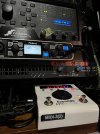Not sure why this would be wrt a clean hi-headtoom power amp (unlike what would be expected for traditional guitar p. a. section via fx return). My Matrix is, as far as I can tell, all clean headroom throughout its range - as this type of power amp should be afaiu. There is no gain staging necessary to Matrix or similar. For a given target volume, I can either feed it a lower signal and turn the Matrix' knobs up to attenuate less, or feed it a higher signal and turn the Matrix' knobs down to attenuate more. Interestingly, I've often read the latter recommendation for Matrix but never citing associated logic. Either way, aside from extreme cases where the amp is pushed beyond a typical use case (which would suggest it's not powerful enough for the task at hand) or fed an extremely quiet signal, I can't descern any difference and would not expect any given this is what Ss power amps are designed to do afaik, and should not require the user to generate an atypically high signal level to feed it.

